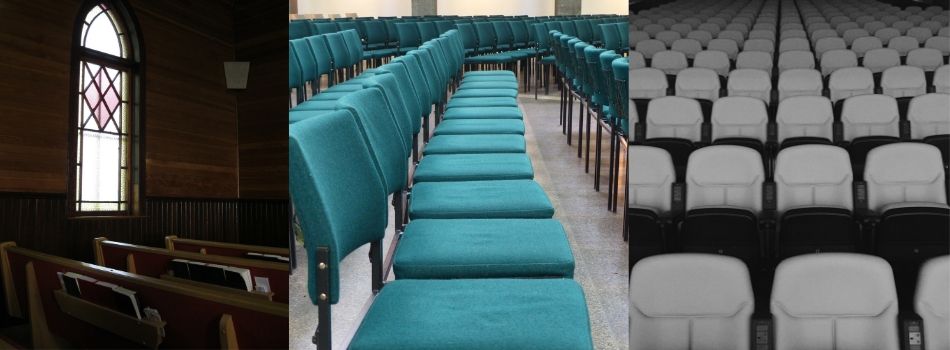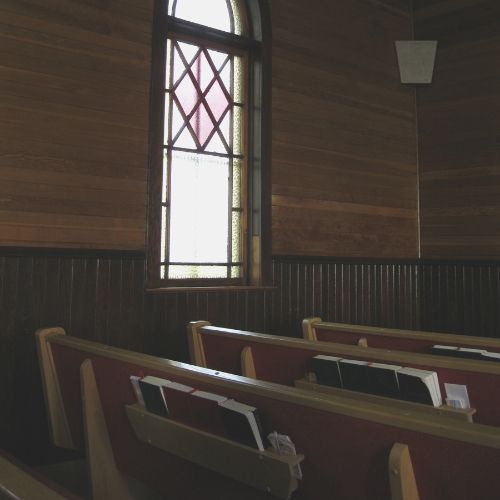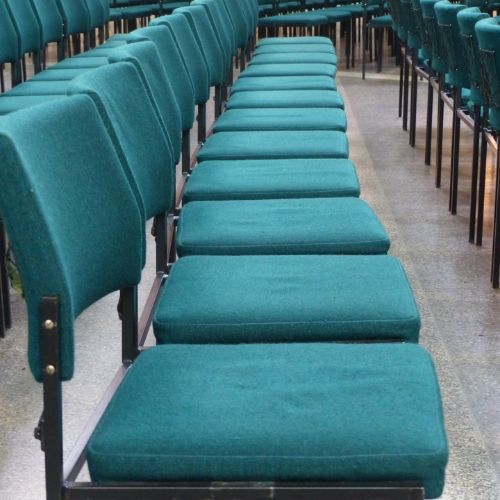
My home church is beginning a church-wide remodel and one of the topics we are discussing is, the choice between chairs, pews or something else in the worship center.
Our answer to this question was… Pew Seats! Let me explain what a pew seat is and why we chose it. While the answer may seem simple, it most certainly was not. After many meetings, conversations, and price comparisons. This was due to our specific needs of mobility and layout variability, pew seats offered more flexibility and comfort not afforded by the pews or fixed theater seating that had made our shortlist.
What are the options?
As the title states, most people only think of either chairs or pews, when it comes to church seating. There is a surprisingly wide realm of seating options. I will narrow it down to the three main categories of church seating. These categories are Pews, Pew Chairs, and Theater Seating.
What is the difference?
- Pews are what you are probably most familiar with is you grew up in a Southern Baptist or Catholic church. These are generally 10+ foot long wooden benches, that line the isles of the worship hall. Bonus points if these were chipped and stained with years forgotten communion wine.

- Pew Seats are stackable chairs that interlock to prevent the rows from separating. These are generally made of upholstered metal and have locking tabs on the side of each seat base.

- Theater Seating is what you would normally find in a theater or university lecture hall. These are either metal or wood and are affixed to the floor to prevent any movement.

Comfort Considerations
There are two types of comfort to consider. First, you have physical comfort this concerns things like padding, legroom, and armrests. Whereas the second type of comfort is more about personal space… or the lack of it, for some people.
- Pews seemed to be last in both of these categories for most people. You have only have an armest on the ends, generally a hard oak panel for a backrest, and limited legroom in front of you. The personal space idea goes completely out the window for an Easter or Christmas service. This sardine-like seating inevitably leads to a mid-sermon call to nursery because of one of your kids.
- Pew Seats allow for more comfort on both fronts, as compared to pews. Generally, the seats have upholstered padding in the seat as well as the back. While there is some consideration left to the efficiency of the layout. Sections can be added and taken away to fit the current occupancy size and traffic flow. So you may only have to step across a few people to attend to your kids, instead of an entire family or two.
- Theater seating wins in both categories. With a comfortable seat designed specifically for one person, all the padding and physical comfort you need is provided. While you will not be asked to sit on your neighbors bible or bulletin after every song.
Capacity Concerns
When considering capacity we need to not just look at the number of “bodies in the seats”. While always staying within local fire code considerations, the more functional seats you have, the more people you can serve. With the increasing size of American’s, many churches (mine included) are now looking to upsize each seat, unfortunately, this cuts into the capacity number. Because of this, efficiency and flexibility are paramount concerns for most churches.
- Pews offer a variety of capacities. This is due to the fluid nature of the seating in the respective pew. While a family may squeeze together, a single visitor may desire a bit of elbow room. If you keep the math simple and average approximately 24 inches for each person, you can do some simple math projections. For example, a 10-foot pew can only seat five people comfortably.
- Pew seats offer the ability to tailor your capacity to actually fit the need and abilities of your location. One of the primary benefits of pew seats is the fact that “extra” seats can be pulled in from elsewhere when the situation warrants it. With the same math used above, you can still only fit five people in a 10-foot seating line. Though the ability to quickly add or subtract to that number is almost instantaneous.
- Theater seating is the worst when taking capacity into account. You are still limited to a fixed number of seats in a specific row, while also not allowing the “scootch together” options of a pew. With the extra size and width of most theater seating, you will be hard press to get more than four chairs in the same 10-foot space.
Price Comparison
This is probably why you found this post in the first place, besides your love of seating equipment 🙂 With finances at a premium across all ministry needs, it is imperative that facilities upkeep run as smoothly and cheaply as possible. This includes the purchase, cleaning, and maintenance of the seats.
- Pews are a large investment for a new church. With an average pew costing anywhere from a few hundred to a few thousand dollars per pew, this is a cost that many church plants can’t handle. If you found a great deal in bulk and were to buy pews at $300/per pew. For a church of three hundred people, you would need sixty pews!
- (300 people) / (5 per pew) x ($300) = $18,000 for seating.
While this may seem completely overwhelming, this is a true investment. The life span of a quality church pew can be easily into the decades. So if your church has embraced the “buy once, cry once” method of finance, pews should be considered.
- Pew seats are the cheapest option on this list. The average price for interlocking pew seats is in the tens-of-dollars range per seat. If you found a great deal on bulk pew seats at $30/per seat. For a church of three hundred people, you would need 300 pew seats.
- (300 seats) x ($30) = $9,000
This number is by far the lowest of the three options. You will not get decades of wear and tear out of most pew seats. Replacements would need to be purchased as the seats wear out. Though this replacement can be done on an as-needed basis, instead of one huge order.
- Theater seating can be found cheaply on the used market. This is great for a small church start. But be sure to take into account the used condition of the seats as well as the potential lack of matching sets. I will not do the math for this one, eBay or some type of secondhand source will vary too wildly in price.
General Flexibility
- Pews have many advantages, flexibility is definitely not one of them. These monsters are big and heavy. So if you have no plans to move, rearrange, or multi-use the worship hall, these are not a bad choice.
- Pew seats offer an unparalleled level of flexibility. From being able to snag a few extra chairs when needed. To the stackable storage taking up less of a footprint. Pew seats truly shine as the Jack-of- all in the seating arena.
- Theater seating offers the least flexibility of all the options. These huge chunks of chair are literally bolted to the floor. So you better make sure you are happy with the style, placement, and quality of the seats BEFORE you start drilling into the slab!
Pros and Cons Summary
Pews
- Pros:
- Nostalgic feeling
- Sturdy construction
- Flexibility for groups to squeeze in
- Cons:
- Cost
- General bulky size and weight
- Limited capacity
- Limited personal space
Pew seats
- Pros:
- Lowers cost
- Ability to buy and replace as needed
- Extreme flexibility in layout and spacing
- Cons:
- No nostalgia
- Seating has less personal feeling
Theater Seating
- Pros:
- Comfort
- Classic looks
- Can be SUPER affordable
- Cons:
- Lack of uniformity
- Zero layout flexibility
- Limited replacement options
In Conclusion
While all of the seating options offer their own strengths and weaknesses, as previously written, we decided on pew seats. This came down to the cost, flexibility, and replaceability/expandability offered by the pew seats. When we grow we can add a few more chairs. When we move to a bigger building we can just buy more to match. Futureproofing the seating of our church was the key option that sold us on pew seats.




